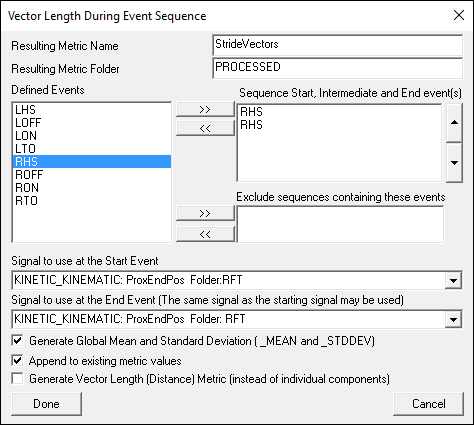Table of Contents
Metric Vector Between Events
Overview
This command creates a metric vector of a signal(s) value between a start and an end event, for example the metric vector of stride length while the foot is in contact with the ground. It can be found within the Pipeline Workshop under Metric.
Pipeline Command
The syntax for the function is as follows:
Metric_Vector_Between_Events ! /RESULT_METRIC_FOLDER=PROCESSED /RESULT_METRIC_NAME= ! /GENERATE_VECTOR_LENGTH_METRIC=FALSE /START_SIGNAL_TYPE= ! /START_SIGNAL_FOLDER=ORIGINAL /START_SIGNAL_NAME= /END_SIGNAL_TYPE= ! /END_SIGNAL_FOLDER=ORIGINAL /END_SIGNAL_NAME= /EVENT_SEQUENCE= /EXCLUDE_EVENTS= ! /GENERATE_MEAN_AND_STDDEV=TRUE ! /APPEND_TO_EXISTING_VALUES=FALSE ! /RETAIN_NO_DATA_VALUES=FALSE ;
Command Parameters
The following table shows the command parameters seen above and their descriptions:
| Metric_Vector_Between_Events | |
| /Metric_Name= | The name of the resulting metric signal. |
| /Generate_Vector_Length_Metric= | (TRUE or FALSE)Compute the length of the vector (e.g. a scalar). |
| /Start_Signal_Name= | The name of the signal whose value will be obtained from the Start Event. |
| /Start_Signal_Type= | The type of the Start Signal. |
| /End_Signal_Name= | The name of the signal whose value will be obtained from the End Event. |
| /End_Signal_Type= | The type of the End Signal. |
| /End_Signal_Folder= | The folder of the End Signal. |
| /Event_Sequence= | A list of events (separated by “+” signs). For example, LHS+RTO |
| /Exclude_Events= | Exclude Sequences containing these Events. |
| /Generate_Mean_And_StdDev= | (True or False)Generate the mean and standard deviation for all of the metrics created |
| /Append to Existing Values= | (True or False)Append this list of metrics to an existing metric of the same result name |
Dialog
The command can be edited in a text editor or in a dialog form. To edit in the dialog pop up form either click on the Edit button in the pipeline workshop or double-click on the pipeline command. The dialog is shown below.
The dialog box allows you to assign values to the command parameters outlined above.
Example: Stride Length Vector for Throwing
A stride length vector (or scalar) can also be calculated in throwing. Events are created that define the particular phases of the throwing motion. Below is an example of calculating a stride length between Arm Cock Start and Lead Foot Contact.
Metric_Vector_Between_Events /RESULT_METRIC_NAME=Stride Length ! /RESULT_METRIC_FOLDER=PROCESSED /GENERATE_VECTOR_LENGTH_METRIC=TRUE /START_SIGNAL_TYPE=KINETIC_KINEMATIC /START_SIGNAL_NAME=ProxEndPos /START_SIGNAL_FOLDER=RFT /END_SIGNAL_TYPE=KINETIC_KINEMATIC /END_SIGNAL_NAME=ProxEndPos /END_SIGNAL_FOLDER=LFT /EVENT_SEQUENCE=ARM COCK START+LEAD FOOT CONTACT /EXCLUDE_EVENTS= ! /GENERATE_MEAN_AND_STDDEV=TRUE /APPEND_TO_EXISTING_VALUES=TRUE ! /RETAIN_NO_DATA_VALUES=FALSE ;
Example: Stride Length Vector for Gait
The example below shows how Metric Vector Between Events can be used to create a stride length vector.
First gait events must be defined using Automatic Gait Events. These events are necessary as they will be referenced in the Stride Vector command:
Automatic_Gait_Events ! /FRAME_WINDOW=8 ! /USE_TPR=TRUE ! /TPR_EVENT_INSTANCE=1 ;
Next, Metric Vector Between Events is used to find the vector between each right heel strike:
Metric_Vector_Between_Events /RESULT_METRIC_NAME=StrideVectors ! /RESULT_METRIC_FOLDER=PROCESSED /GENERATE_VECTOR_LENGTH_METRIC=FALSE /START_SIGNAL_TYPE=KINETIC_KINEMATIC /START_SIGNAL_NAME=ProxEndPos /START_SIGNAL_FOLDER=RFT /END_SIGNAL_TYPE=KINETIC_KINEMATIC /END_SIGNAL_NAME=ProxEndPos /END_SIGNAL_FOLDER=RFT /EVENT_SEQUENCE=RHS+RHS /EXCLUDE_EVENTS= ! /GENERATE_MEAN_AND_STDDEV=TRUE /APPEND_TO_EXISTING_VALUES=TRUE ! /RETAIN_NO_DATA_VALUES=FALSE ;
Note: To get stride length, use the parameter /GENERATE_VECTOR_LENGTH_METRIC=TRUE to create the scalar of the stride vector.
The results will look similar to this:
Visual3D Versions supporting Subject Prefixes
NOTE: When using events in a command, the commands will iterate across subjects contained in the current workspace. As such, events and sequences listed as command parameters should NOT contain a prefix. As each subject is processed, the event range/sequence specified will automatically use the specific events prefixed for each subject as they are processed.


